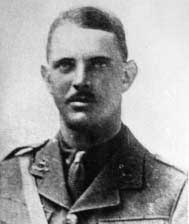Clement Robertson facts for kids
Quick facts for kids
Clement Robertson
|
|
|---|---|
 |
|
| Born | 15 December 1890 Pietermaritzburg, Colony of Natal |
| Died | 4 October 1917 (aged 26) Polygon Wood, Broodseinde, Passchendaele salient, Belgium |
| Buried | |
| Allegiance | |
| Service/ |
|
| Rank | Captain |
| Unit | The Queen's (Royal West Surrey Regiment) (Attached Tank Corps) |
| Wars | World War I |
| Awards | |
Clement Robertson (born December 15, 1890 – died October 4, 1917) was a brave soldier. He was born in the Colony of Natal, which is now part of South Africa. He received the Victoria Cross, the highest award for bravery in the face of the enemy. This award is given to soldiers from Britain and Commonwealth countries.
Clement Robertson's Victoria Cross was given to him after he died. It was the first one ever given to a soldier from the Tank Corps.
Contents
Early Life
Clement Robertson was the fourth son of Major John Albert Robertson. His mother was Frances Octavia Caroline Robertson. Clement was born in Pietermaritzburg, South Africa, on December 15, 1890. His father was a soldier in the Royal Artillery.
Clement's mother's family was from Ireland. He grew up in a place called Delgany in County Wicklow, Ireland.
He went to Haileybury College from 1904 to 1906. After that, he studied Engineering at Trinity College Dublin. He finished his studies in 1909. Then, he went to Egypt to work on a project to water crops using the Nile River.
Military Career
When the First World War started, Clement returned to England. He joined the army on October 8, 1914. He became an officer in The Queen's (Royal West Surrey Regiment) in January 1915.
Later, he worked with the Royal Engineers. From February 1917, he joined the Tank Corps. This was a new part of the army that used tanks.
Battle of Messines
On June 7, 1917, Clement was involved in the Battle of Messines. His Mark IV tank was hit by an enemy shell. A sergeant was killed, and two other crew members were hurt. Even though his tank was badly damaged, Clement managed to drive it back to safety.
Bravery at Broodseinde
Clement was 26 years old and an acting captain. He was with the Tank Corps during the Battle of Broodseinde. This is where he showed amazing bravery and earned the Victoria Cross.
On October 4, 1917, in Zonnebeke, Belgium, Clement led his tanks in an attack. The area was very muddy and full of shell holes. He knew it was risky for the tanks to get lost. So, he walked in front of them, guiding them carefully. He led them towards their target, even though he knew it was very dangerous.
German machine-gun nests, called pillboxes, were causing many casualties. Clement, with the help of one of his tanks, captured these pillboxes. This allowed the British soldiers to reach higher ground.
Clement was killed after his tanks reached their goal. His brave leadership helped the attack succeed. His actions showed incredible courage and dedication to his duty.
After the Battle
Because Clement had not married, his Victoria Cross was given to his mother. The ceremony took place in Dublin on March 27, 1918.
Clement is believed to be buried at Oxford Road Commonwealth War Graves Commission Cemetery. This cemetery is near Ypres in Belgium. His headstone has a Latin phrase: VIRTUTIS GLORIA MERCES. This means "glory is the reward of virtue."
A soldier named Private Allen had walked with Clement during the attack. He was also very brave and received a medal called the Distinguished Conduct Medal. Private Allen was killed later in 1917.
Memorials
Clement Robertson is remembered in several places:
- In his church, Christ Church, in Delgany, County Wicklow, Ireland.
- At Delgany Golf Club, where he and his brothers were founding members. He won a prize there in 1908.
- On a wall in the entrance hall of the Reading Room at Trinity College Dublin.
- With a plaque and a Royal Tank Regiment flag at Merlijn Restaurant in Belgium.
- A bridge over the Reutelbeek stream was named "Robertson's Bridge" in October 2017.
- At Glasnevin Cemetery in Dublin. One of four special stones was placed there in 2017. These stones honor Irish soldiers who received the Victoria Cross in the First World War.

